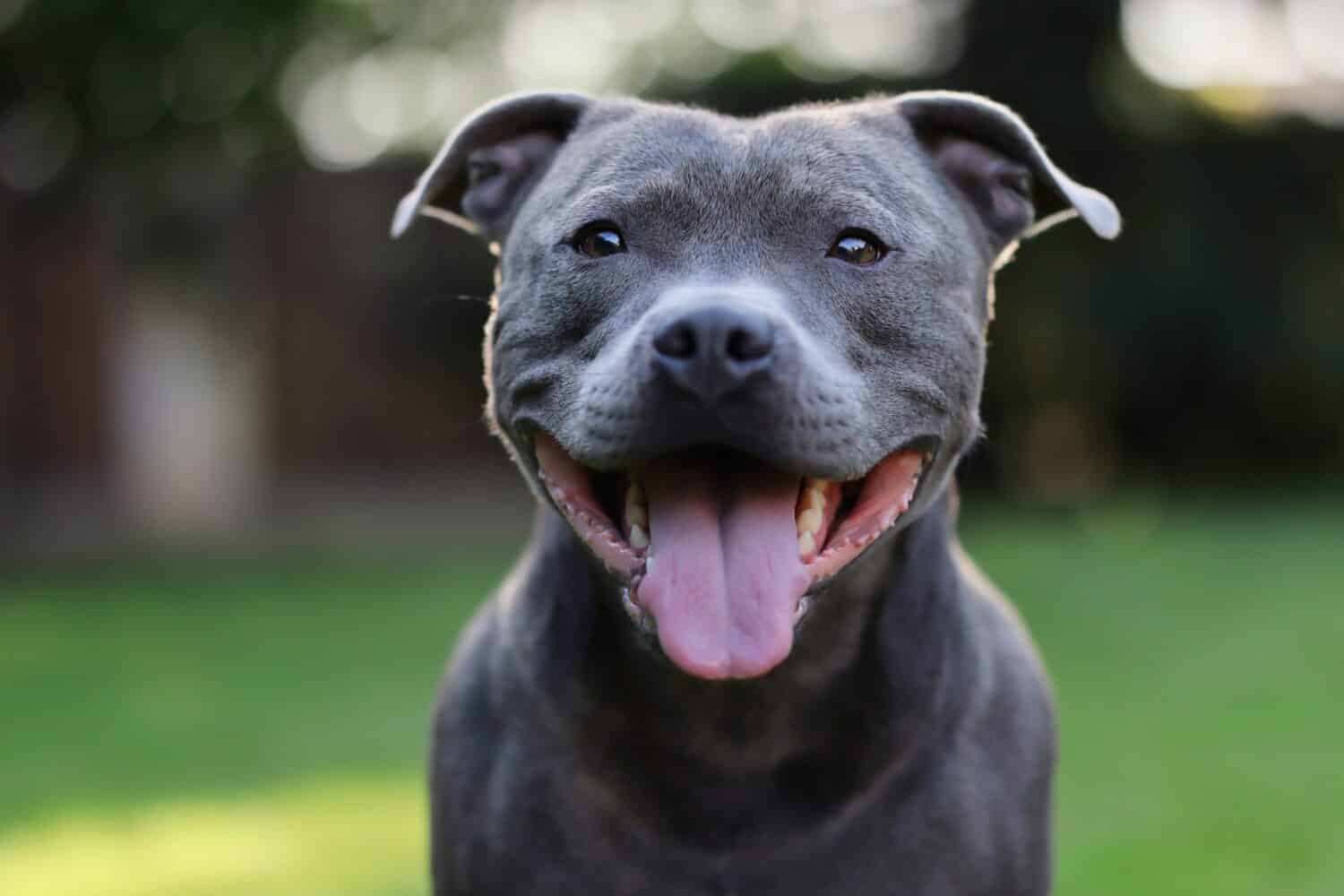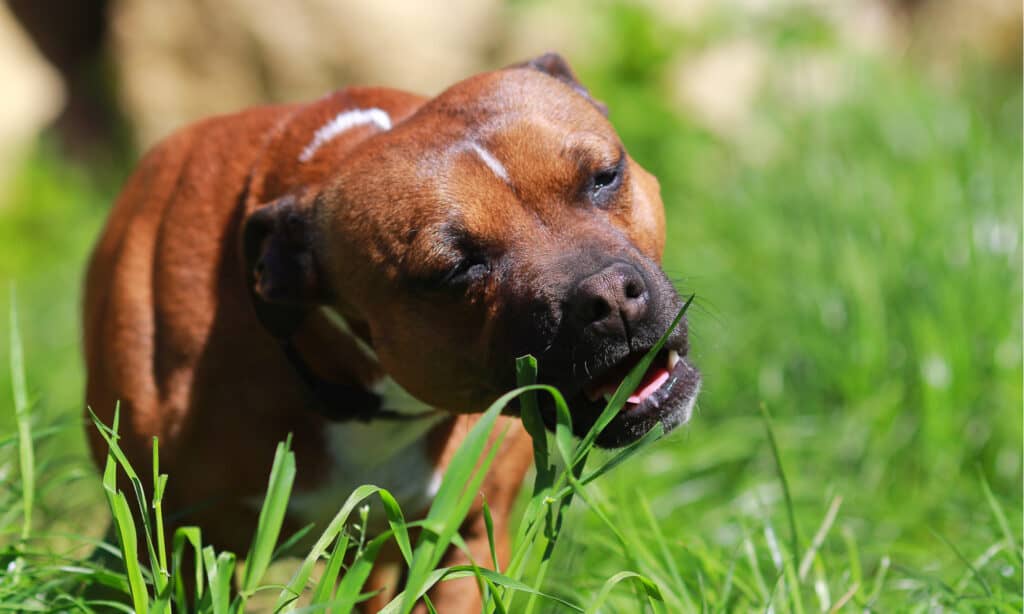Welcome to our article on the lifespan of Staffordshire bull terriers! If you’re a proud owner or considering bringing home one of these lovable and energetic dogs, it’s essential to understand how long they typically live. In this comprehensive guide, we will delve into various factors that can influence the lifespan of Staffordshire bull terriers. We will shed light on their average life expectancy as well as tips for maximizing their longevity and overall well-being. Whether you’re curious about the potential health issues that may affect them or seeking advice on providing optimal care for your furry companion, this article aims to equip you with all the information you need to ensure a happy and healthy life for your beloved Staffie. So let’s dive in!

About the Breed

Staffordshire bull terriers live for 12-14 years with excellent care.
©Melounix/Shutterstock.com
Originally bred for fighting, the Staffordshire Bull Terrier still carries the traits of courage and tenacity from its brawling past. However, through careful breeding and responsible practices, this once fierce gladiator has been transformed. Staffies are now mild-mannered and playful companions with an exceptional affinity for children.
Despite standing at just 14 to 16 inches in height, Staffordshire bull terriers are known for their compact yet robust build. Weighing anywhere between 24 to 38 pounds, these dogs pack a gallon’s worth of energy and strength into a quart-sized container. Their muscular physique portrays them as solid terriers capable of enduring physical activities.
The breed’s distinct features include a short and broad head with well-defined cheek muscles. Additionally, they possess a tight-fitting coat that comes in various colors, adding to their visual appeal.
While Staffies may still bear some resemblance to the pugnacious brawlers of England’s fighting pits in appearance, modern-day responsible breeders have successfully produced sweet-natured individuals eager to please their human companions. People love these loyal companions for their patience with every member of the family.
Although Staffies have developed into affectionate pets over time, remnants of their old fighting instinct may still persist within certain individuals. This emphasizes the importance of early socialization during puppyhood. Introducing them to other dogs early helps them learn proper canine manners.
Staffordshire Bull Terrier Lifespan

You can ensure a long healthy life for your
Staffordshire bull terrier
by providing high-quality food.
©Nikola Cedikova/Shutterstock.com
When it comes to the lifespan of a Staffordshire bull terrier, there are several factors that can influence how long these beloved dogs live. Staffordshire bull terriers have an average life expectancy of 12-14 years. But understanding the various elements that impact their lifespan can provide valuable insights for dog owners and enthusiasts alike.
One crucial factor contributing to a Staffordshire bull terrier’s longevity is genetics. Like any living creature, dogs inherit certain traits from their parents and ancestors. Therefore, responsible breeding practices play a significant role in ensuring healthier bloodlines with fewer hereditary health issues. By selecting breeding pairs carefully based on genetic health screenings and avoiding lineages prone to certain ailments, breeders can promote longer lifespans in future generations.
Additionally, proper nutrition plays a vital part in determining a dog’s lifespan. A well-balanced diet tailored to meet the specific needs of Staffordshire bull terriers helps maintain their overall health and strengthens their immune system. Providing them with high-quality food rich in essential nutrients such as proteins, vitamins, minerals, and omega fatty acids ensures they receive optimal nourishment throughout their lives.
Regular veterinary care is another critical aspect influencing a Staffordshire bull terrier’s lifespan. Routine check-ups at the veterinarian’s office are a good idea. The vet will monitor the dog’s overall health and promptly address any emerging medical concerns before they escalate into more serious problems. Vaccinations protect them from infectious diseases prevalent among dogs.
Grooming

Early socialization is key to a long, happy life for your Staffordshire bull terrier.
©Christine Bird/Shutterstock.com
Keeping a Staffordshire bull terrier looking their best is a relatively low-maintenance task. With just a few simple grooming practices, you can ensure that your furry friend stays in beautiful condition. Regular baths, although not frequently required, will help to keep their coat clean and shiny. Additionally, weekly brushings using either a mitt or glove can effectively remove dead hairs and prevent excessive shedding.
Another important aspect of grooming is nail care. Professionals recommend trimming the dog’s nails at least once a month to avoid any discomfort or pain caused by overly long nails. Neglecting this aspect can result in difficulties during walks or even lead to potential foot problems for the dog.
Furthermore, it is crucial to pay attention to the cleanliness of their ears. Excess wax and debris accumulation can potentially lead to ear infections if left unattended. To prevent this from happening, regular cleaning sessions are necessary. Both your groomer and veterinarian can guide you in establishing an appropriate routine for ear cleaning. They can also suggest suitable cleaning materials specifically tailored for these purposes.
By following these simple grooming routines provided by professionals familiar with Staffordshire bull terriers’ needs, you will be able to maintain your beloved pet’s overall health while also ensuring they look their absolute best throughout their lifetime.
Exercise

Exercise can help increase your Staffordshire bull terriers’ lifespan and yours too!
©iStock.com/Maryna Rayimova
Regular exercise is essential for the well-being and maximum life expectancy of Staffordshire bull terriers. These energetic dogs thrive on physical activity and mental stimulation. Engaging in activities such as chasing a ball or going on long hikes through nature keeps them physically fit. It also helps to keep their minds sharp.
Staffords are known for their athleticism, and they can easily keep up with an active owner during activities like biking or jogging. Their strong muscles and agile bodies make them excellent companions for outdoor enthusiasts seeking a four-legged partner to join them on adventures.
However, it’s important to note that despite their endurance, Staffords tend to settle down quickly once back inside the house after a satisfying exercise session. They appreciate having some downtime to relax and recharge before engaging in any further activities.
One aspect that owners must be mindful of is the breed’s sensitivity to heat. Staffordshire bull terriers can become intolerant of high temperatures, so it is crucial never to overwork them in warm or humid weather conditions. Heatstroke can be extremely dangerous for these dogs, making it vital for owners to monitor their pet’s comfort levels during hot weather and ensure they have access to shade and water at all times.
In conclusion, maintaining an active lifestyle with regular exercise sessions tailored to a Staffordshire bull terrier’s needs will contribute significantly towards extending their lifespan.
Training

Staffordshire bull terriers are intelligent dogs that are a joy to train.
©Eric Isselee/Shutterstock.com
In addition to their intelligence and quick learning abilities, Staffordshire bull terriers possess a calm and protective nature that makes them excellent companions. Their strong desire to please their owners enables them to readily comply with commands and requests. However, it is important to remember that people originally bred these dogs for dog fighting, which has instilled in them a powerful prey drive.
To ensure that Stafford puppies grow into well-behaved pets, consistent training from an early age is crucial. It is not enough for them to simply learn the rules. They must also understand the importance of always adhering to them. By establishing clear boundaries and expectations right from the start, owners can help their Staffords develop self-control over their natural temperament traits.
While training focuses on instilling discipline and obedience in these dogs, it should never overlook the fundamental aspect of building a close bond between owner and pet. Forming a relationship based on trust and mutual understanding plays an integral role in successful dog training endeavors. When you establish this connection, Staffordshire bull terriers are more likely to thrive as loving companions who bring joy and fulfillment into their owners’ lives.
History of the Breed

Staffordshire bull terriers have evolved from a fighting breed to a wonderful companion animal.
©Melounix/Shutterstock.com
The background of the Staffordshire bull terrier is a relatively short one in the long history of canines. It is even more complicated by the various different names given to the breed in the past. Notable examples include the bull-and-terrier, the Staffordshire pit dog, the patched fighting terrier, and the brindle bull.
Staffordshire Bull Terriers are considered “bull types” of terriers, according to the American Kennel Club, alongside other breeds such as the bull terrier and the American Staffordshire terrier. This type of breed has a shared history, which dates back several centuries ago in England when people used to gamble on dog-related combat sports. This tradition began with the bulldog, which people bred to excel in these cruel activities, specifically bull-baiting.
When bull-baiting was outlawed in 1835, betting on pit dogs became an illegal activity. Gamblers mixed bulldogs, who had lost their jobs due to the ban, with energetic terriers to create a breed of combat dogs with the strong jaws of a bulldog and the liveliness of a terrier. These fights were often held in hidden cellars to avoid legal consequences.
James Hinks of Birmingham, England, contributed significantly to the creation of the Staffordshire bull terrier in the mid-1800s. You can tell this type of terrier apart from others by its burly and wide-skulled features. This breed has remained successful and popular for many years.
In the late 1800s, the Staffordshire bull came to North America, and breeders made it into the larger, heavier American Staffordshire terrier, or AmStaff. Over the past century, careful breeding has changed both breeds from fighters to loyal family pets.
The photo featured at the top of this post is © Hamik/Shutterstock.com
Ready to discover the top 10 cutest dog breeds in the entire world?
How about the fastest dogs, the largest dogs and those that are -- quite frankly -- just the kindest dogs on the planet? Each day, AZ Animals sends out lists just like this to our thousands of email subscribers. And the best part? It's FREE. Join today by entering your email below.
Thank you for reading! Have some feedback for us? Contact the AZ Animals editorial team.







